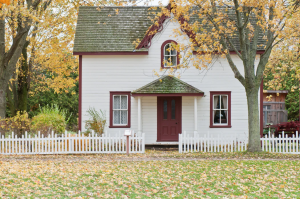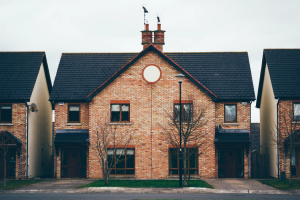When people talk about homeowners insurance, they typically want to know how much homeowners insurance costs or how to get it.
A basic homeowners insurance policy does not cover every disaster that may occur in your home. For instance, damage caused by termites and insects, birds or rodents, rust, rot, mildew, and normal wear and tear is not typically covered under homeowners insurance.
In most cases, when you have a mortgage, you must have homeowners insurance, but a typical policy may not cover damages from earthquakes or flooding as well. Understanding how and why homeowners insurance came to be can help you comprehend why some parts of home insurance are now more expensive.
How Homeowners Insurance Got Its Start
Insurance has been around for a long time. The Great Fire of London in 1666 marked the beginning of modern home insurance. Over 13,000 homes were destroyed in the fire, leaving hundreds of people without a place to call home.
Insurance existed in various forms before this, but it lacked the universality and regulations of today’s insurance policies. During the 17th century, each insurance contract only covered one possible occurrence.
If insurance had not changed, a modern homeowner would require unique and individual policies for fire insurance, lightning insurance, burglary insurance, and so on. However, a basic homeowners insurance policy now covers all of this.
Since residences were built close together to create a way to house individuals in crowded communities in the 17th century, fires were a significant worry during that era. Therefore, homeowners insurance plans focused on individual fire or lightning coverage — the need for bundling insurance coverage was not yet common enough.
In addition, fires were a significant issue because of the material used to construct homes. Unlike how bricks and steel buildings are used when building residences now, dwellings were made of wood back then.
Wooden frames are prone to burning, which is a hazard. As the population grew, developers built residences closer and closer together, increasing the chances of a fire breaking out. People then began to understand the importance of protecting their properties with insurance.
When was the first home insurance introduced?
In 1732, insurance was introduced to the United States, with the founding of the first fire insurance business in Charleston, South Carolina. “Charles Town” was the name of the town at the time.
The notion of fire insurance would not gain traction until about 20 years later when Benjamin Franklin created it. He was the founder of the Philadelphia Contributionship for the Insurance of Houses Against Fire Loss.
This firm is still in operation today. Many individuals have benefited from the organization’s assistance in averting fires and establishing corporate standards.
In 1751, the board of directors, of which Franklin was a member, voted to form the insurance company. Members agreed to pay equal contributions to the contributionship, which would be used to compensate for any losses incurred by anybody whose home was damaged by fire. The earliest insurance policy was limited to seven years.
Though Benjamin Franklin could not foresee the insurance industry’s massive expansion, his initial concept spawned many other insurance firms and policies. Benjamin Franklin’s initial idea is the foundation of all policy coverage in the home insurance sector.
Life insurance (which was initially meant to aid widows and children), burglary insurance, disability insurance, industrial insurance, and automobile insurance all developed from a simple idea to create a fire insurance policy.
Who regulates the home insurance industry?
The states are in charge of insurance regulation, including home insurance. This regulatory structure is based on the McCarran-Ferguson Act of 1945, which declares state control and taxation of the business in the public interest. It gives it clear precedence over federal law.
Therefore, every state has its own set of laws and regulations.
Insurance was essentially an uncontrolled and unrestricted commodity. Few rules existed, monopolies arose, and minority groups were exempt. Carriers charged whatever premiums they could (typically the maximum) and were never able or willing to pay more than the minimum for claims.
At the turn of the century, the government achieved steady legislative progress in the private insurance sector.
The Social Security Act of 1935, which gave employees access to unemployment benefits, and the McCarran-Ferguson Act of 1945 (as mentioned briefly earlier), which gave the government control over the insurance sector, were two of the most important legislation to the insurance industry.
These two laws changed the insurance industry’s dynamics, making it more consumer-friendly. Insurance companies have since been compelled to do BCG, eliminate discriminatory plans, offer fairer prices, and refund verified claims due to government regulation and rigorous competition among insurers and they have been doing this by Fully-Verified.
How is the cost of homeowners insurance determined?
Many factors influence the cost of homeowners insurance. The home’s replacement cost is typically the most important determining factor, with a higher house cost equaling higher premiums.
A larger house’s square footage costs more to rebuild and has higher insurance premiums. Furthermore, having a larger number of primary residents raises the risk of liabilities, resulting in higher rates.
The net average gross premium for homeowners insurance is about $1,300 per year or $109 per month for a property with a dwelling coverage level of $250,000. Premiums range from a few hundred dollars per year to more than $3,000 in some areas, and homeowners pay around 2% of their income on them.
Financial institutions that manage the mortgage or home equity line of credit generally require homeowners insurance to protect themselves in the case of property damage.
Insurance usually covers the construction of your home and built-in appliances, as well as any standalone structures on your property. Your furnishings and any liabilities or expenses incurred as a result of any damage are also covered.
Overall, the cost of homeowners insurance varies by state, but it’s increasing worldwide. In addition to industry-wide price hikes, your homeowners insurance estimates may be expensive due to your credit, the age and value of your property, the kind of construction, location, and vulnerability to disasters, among other variables.
In most situations, both your annual property tax and your annual insurance coverage will rise year after year. Insurance companies boost premiums to keep up with the rising cost of repairing or replacing your property due to inflation.
Find Home Insurance that Meets Your Needs
In the long run, the history of home insurance led to government regulation, which prohibits firms from billing you for coverage you don’t need.
Since the creation and growth of the internet, consumers have been able to search the web at home for affordable insurance coverage without worry about being taken advantage of by the insurance industry. The regulatory action aims to guarantee that insurers stick to their contractual commitments.
Imani Francies writes and researches for the insurance comparison site, ExpertInsuranceReviews.com. She enjoys helping people learn about the details of homeowners insurance so they can choose a policy that meets their specific needs.


